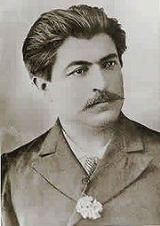
Antoin Sevruguin
Encyclopedia
Antoin Sevruguin was a photographer in Iran
during the reign of the Qajar dynasty
(1785–1925).
family in the Russian embassy of Tehran
, Persia: Antoin Sevruguin was one of the many children of Vassil de Sevruguin and a Georgian Achin Khanoum. Vassil de Sevruguin was a diplomat to Tehran. Achin had raised her children in Tbilisi, Georgia, because she was denied her husband’s pension. After Vassil died in a horse riding accident Antoin gave up the art form of painting
, and took up photography to support his family. His brothers Kolia and Emanuel helped him set up a studio in Tehran on Ala al-dawla Street (today Ferdowsi St.).
 Many of Antoin’s photographs were taken from 1870-1930. Because Sevruguin spoke Persian
Many of Antoin’s photographs were taken from 1870-1930. Because Sevruguin spoke Persian
as well as other languages, he was capable of communicating to different social strata and tribes from his country Iran. His photos of the royal court, harem
s, and mosque
s and other religious monuments were compared to the other Western photographers in Persia. The reigning Shah, Nasir al-Din Shah (reigned from 1846–1896) took a special interest in photography and many royal buildings and events were portrayed by Sevruguin.
Photographic studio's in the ninetheenth century advertised a type of picture known in French as "types". These were portraits of typical ethnic groups and their occupation. They informed the European viewer, unfamiliar with Persian culture, about the looks of regional dress, handcraft, religion
and professions. Photographing regional costums a was an accepted method of ethnological research in the nineteenth century. Many European ethnological museums bought Sevruguins portraiture to complement their scientific collection. Museums collected pictures of merchants in the bazaar, members of a zurkhana (a wrestling school), dervishes, gatherings of crowds to see the taziyeh theatre, people engaged in shiite rituals and more. Sevruguins portraits were also spread as postcards with the text: 'Types persans'.
Sevruguin was a photographer who had no boundaries in portraying people of all sorts of social classes and ethnic backgrounds. He portrayed members of the Persian royal family as well as beggars, fellow countrymen of Iran or Westerners, farmers working fields, womenweavers at work, army officers, religious officials, Zoroastrians, Armenians, Lurs
, Kurds, Shasavan, Chaldeans, Gilak, Afghans
.
of Muhammad Ali Shah
(reigned from 1907–1909) inadvertently bombed his store in suppression of Zahiru’d-Dawla, the constitutionalist
Governor of Rasht
. His house, along with the whole street was burned.
Up to that point Antoin had seven thousand plus photographs. Only two thousand were salvaged. In an attempt to modernize Persia Reza Shah Pahlavi(reigned from 1925–1941) confiscated the remaining traditional images.
(reigned 1941–1979). 696 of his negatives survive today.
Iran
Iran , officially the Islamic Republic of Iran , is a country in Southern and Western Asia. The name "Iran" has been in use natively since the Sassanian era and came into use internationally in 1935, before which the country was known to the Western world as Persia...
during the reign of the Qajar dynasty
Qajar dynasty
The Qajar dynasty was an Iranian royal family of Turkic descent who ruled Persia from 1785 to 1925....
(1785–1925).
Early life
Born into a mixed Armenian-GeorgianGeorgian people
The Georgians are an ethnic group that have originated in Georgia, where they constitute a majority of the population. Large Georgian communities are also present throughout Russia, European Union, United States, and South America....
family in the Russian embassy of Tehran
Tehran
Tehran , sometimes spelled Teheran, is the capital of Iran and Tehran Province. With an estimated population of 8,429,807; it is also Iran's largest urban area and city, one of the largest cities in Western Asia, and is the world's 19th largest city.In the 20th century, Tehran was subject to...
, Persia: Antoin Sevruguin was one of the many children of Vassil de Sevruguin and a Georgian Achin Khanoum. Vassil de Sevruguin was a diplomat to Tehran. Achin had raised her children in Tbilisi, Georgia, because she was denied her husband’s pension. After Vassil died in a horse riding accident Antoin gave up the art form of painting
Painting
Painting is the practice of applying paint, pigment, color or other medium to a surface . The application of the medium is commonly applied to the base with a brush but other objects can be used. In art, the term painting describes both the act and the result of the action. However, painting is...
, and took up photography to support his family. His brothers Kolia and Emanuel helped him set up a studio in Tehran on Ala al-dawla Street (today Ferdowsi St.).
Celebrity

Persian language
Persian is an Iranian language within the Indo-Iranian branch of the Indo-European languages. It is primarily spoken in Iran, Afghanistan, Tajikistan and countries which historically came under Persian influence...
as well as other languages, he was capable of communicating to different social strata and tribes from his country Iran. His photos of the royal court, harem
Harem
Harem refers to the sphere of women in what is usually a polygynous household and their enclosed quarters which are forbidden to men...
s, and mosque
Mosque
A mosque is a place of worship for followers of Islam. The word is likely to have entered the English language through French , from Portuguese , from Spanish , and from Berber , ultimately originating in — . The Arabic word masjid literally means a place of prostration...
s and other religious monuments were compared to the other Western photographers in Persia. The reigning Shah, Nasir al-Din Shah (reigned from 1846–1896) took a special interest in photography and many royal buildings and events were portrayed by Sevruguin.
Landscape photography
Because Sevruguin travelled Persia and took pictures of the country, his travels record the Iran as it was in his time. Sevruguins pictures show Tehran as a small city. They show monuments, bridges and landscapes which have changed since then.Ethnographical photography
Some of Sevruguin's portraiture fed preexisting stereotypes of Easterners but nevertheless had a commercial value and today prove to be historical records of regional dress.Photographic studio's in the ninetheenth century advertised a type of picture known in French as "types". These were portraits of typical ethnic groups and their occupation. They informed the European viewer, unfamiliar with Persian culture, about the looks of regional dress, handcraft, religion
Religion in Iran
Most Iranians are Muslims. Around 89% belong to Shi'a branch of Islam, the official state religion, and about 9% belong to the Sunni branch of Islam. The remaining 2% are non-Muslim religious minorities, including Bahá'ís, Mandeans, Yarsanis, Zoroastrians, Jews, and Christians...
and professions. Photographing regional costums a was an accepted method of ethnological research in the nineteenth century. Many European ethnological museums bought Sevruguins portraiture to complement their scientific collection. Museums collected pictures of merchants in the bazaar, members of a zurkhana (a wrestling school), dervishes, gatherings of crowds to see the taziyeh theatre, people engaged in shiite rituals and more. Sevruguins portraits were also spread as postcards with the text: 'Types persans'.
Sevruguin was a photographer who had no boundaries in portraying people of all sorts of social classes and ethnic backgrounds. He portrayed members of the Persian royal family as well as beggars, fellow countrymen of Iran or Westerners, farmers working fields, womenweavers at work, army officers, religious officials, Zoroastrians, Armenians, Lurs
Lurs
Lurs are an Iranic people living mainly in south-western Iran. Their population is estimated at above two million. They occupy Lorestan, Bakhtiari, and Kuh-Gilu-Boir Ahmed. "....
, Kurds, Shasavan, Chaldeans, Gilak, Afghans
Afghanistan
Afghanistan , officially the Islamic Republic of Afghanistan, is a landlocked country located in the centre of Asia, forming South Asia, Central Asia and the Middle East. With a population of about 29 million, it has an area of , making it the 42nd most populous and 41st largest nation in the world...
.
Sevruguin's photographic studio
Many Westerners who lived in Persia and travellers who visited the country brought back pictures from Sevruguin, mentioning him in travelogues of the time. Sevruguin's photographic studio was located on the Avenue Al-Dawla and was not the only photographic studio in this street. Local people could have their picture taken in this studio as well. They could pose in front of a painted backdrop. Most pictures were taken as a glass negative and printed out as an albumen print. Often a logo with Sevruguin's name was printed on one side of the picture. Many 19th century tourists misspelled his name, finding it difficult to spell it in Western languages: Sevraguine, Sevrugin, Sevriogin, Segruvian, and Serunian for example. His name was phonetically spelled Sevr-joe-gien.Vandalism
In 1908 the world was denied the rich collection of Sevruguin’s images when CossacksPersian Cossack Brigade
The Persian Cossack Brigade was an elite cavalry unit formed in 1879 in Iran. During much of their history they were the only functional, effective military unit of the Qajar Dynasty...
of Muhammad Ali Shah
Mohammad Ali Shah Qajar
Mohammad Ali Shah Qajar was the Shah of Persia from 8 January 1907 to 16 July 1909.-Biography:He was against the constitution that was ratified during the reign of his father, Mozzafar-al-Din Shah...
(reigned from 1907–1909) inadvertently bombed his store in suppression of Zahiru’d-Dawla, the constitutionalist
Iranian Constitutional Revolution
The Persian Constitutional Revolution or Iranian Constitutional Revolution took place between 1905 and 1907...
Governor of Rasht
Rasht
Rasht is a city in and the capital of Gilan Province, Iran. At the 2006 census, its population was 551,161, in 159,983 families.Rasht is the largest city on Iran's Caspian Sea coast. It is a major trade center between Caucasia, Russia and Iran using the port of Bandar-e Anzali...
. His house, along with the whole street was burned.
Up to that point Antoin had seven thousand plus photographs. Only two thousand were salvaged. In an attempt to modernize Persia Reza Shah Pahlavi(reigned from 1925–1941) confiscated the remaining traditional images.
Legacy
After his death from a kidney infection Sevruguin’s images resurfaced. He was survived by seven children from his marriage to Louise Gourgenian. His daughter Mary reclaimed a portion of the photos through a friendship with Muhammad Reza Shah PahlaviMohammad Reza Pahlavi
Mohammad Rezā Shāh Pahlavi, Shah of Iran, Shah of Persia , ruled Iran from 16 September 1941 until his overthrow by the Iranian Revolution on 11 February 1979...
(reigned 1941–1979). 696 of his negatives survive today.

